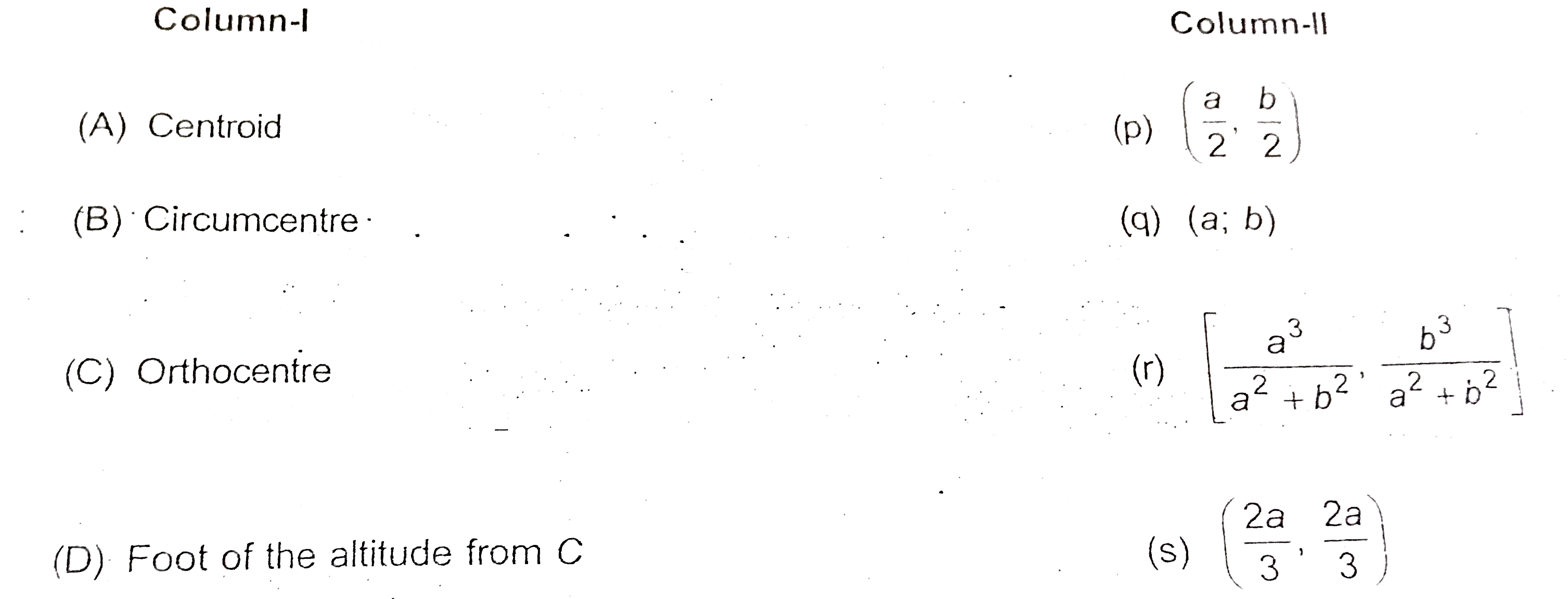The area of a triangle with vertices (a,b+c), (b,c+a) and (c,a+b) is
(a+b+c)2
0
(a + b + c)
abc
The correct Answer is:b
To find the area of the triangle with vertices at (a, b+c), (b, c+a), and (c, a+b), we can use the formula for the area of a triangle given its vertices:
Area=12|x1(y2−y3)+x2(y3−y1)+x3(y1−y2)|
Step 1: Identify the vertices
Let:
- (x1,y1)=(a,b+c)
- (x2,y2)=(b,c+a)
- (x3,y3)=(c,a+b)
Step 2: Substitute the values into the area formula
Substituting the coordinates into the area formula:
Area=12|a((c+a)−(a+b))+b((a+b)−(b+c))+c((b+c)−(c+a))|
Step 3: Simplify each term inside the absolute value
Now, we simplify each term:
1. For the first term:
a((c+a)−(a+b))=a(c+a−a−b)=a(c−b)
2. For the second term:
b((a+b)−(b+c))=b(a+b−b−c)=b(a−c)
3. For the third term:
c((b+c)−(c+a))=c(b+c−c−a)=c(b−a)
Step 4: Combine the terms
Now, we combine these results:
Area=12|a(c−b)+b(a−c)+c(b−a)|
Step 5: Expand and simplify
Expanding this expression:
=12|ac−ab+ab−bc+cb−ac|
Notice that ac and −ac cancel out, and −ab and ab also cancel out:
=12|−bc+cb|=12|0|=0
Conclusion
Thus, the area of the triangle is:
Area=0
Let:
- (x1,y1)=(a,b+c)
- (x2,y2)=(b,c+a)
- (x3,y3)=(c,a+b)
Substituting the coordinates into the area formula:
Now, we simplify each term:
a((c+a)−(a+b))=a(c+a−a−b)=a(c−b)
b((a+b)−(b+c))=b(a+b−b−c)=b(a−c)
c((b+c)−(c+a))=c(b+c−c−a)=c(b−a)
Now, we combine these results:
Area=12|a(c−b)+b(a−c)+c(b−a)|
Expanding this expression:
=12|ac−ab+ab−bc+cb−ac|
Notice that ac and −ac cancel out, and −ab and ab also cancel out:
=12|−bc+cb|=12|0|=0
Thus, the area of the triangle is:
Area=0
Topper's Solved these Questions
- COORDINATE GEOMETRYBOOK - NCERT EXEMPLAR ENGLISHCHAPTER - COORDINATE GEOMETRYEXERCISE - Exercise 7.2 Very Short Answer Type Questions
12 Videos
- COORDINATE GEOMETRYBOOK - NCERT EXEMPLAR ENGLISHCHAPTER - COORDINATE GEOMETRYEXERCISE - Exercise 7.3 Very Short Answer Type Questions
20 Videos
- CONSTRUCTIONSBOOK - NCERT EXEMPLAR ENGLISHCHAPTER - CONSTRUCTIONSEXERCISE - Exercise 10.4 Long Answer type Questions
7 Videos
- INTRODUCTION TO TRIGoNOMETRY AND ITS APPLICATIONSBOOK - NCERT EXEMPLAR ENGLISHCHAPTER - INTRODUCTION TO TRIGoNOMETRY AND ITS APPLICATIONSEXERCISE - LONG ANSWER TYPES QUESTIONS
18 Videos
Similar Questions
Knowledge Check
If origin is the centroid of a triangle ABC having vertices A(a,1,3), B(-2,b,-5) and C(4,7, c) , then the values of a, b, c are
Aa = - 2, b = 8 , c = 2Ba = 2, b = 8, c = - 2Ca = 2, b = - 8, c = 2Da = - 2, b = - 8, c = 2
Write the area of the triangle having vertices at (a,b+c), (b,c+a), (c,a+b).
View SolutionThe area of the triangle formed by (a,b+c),(b,c+a)and(c,a+b) is (a) a+b+c (b) abc (c) (a+b+c)2 (d) 0
View SolutionIn a ΔABC,a,b,A are given and c1,c2 are two values of the third side c. The sum of the areas two triangles with sides a,b,c1anda,b,c2 is
View SolutionIf Δ is the area of a triangle with side lengths a,b,c, then show that as Δ≤14√(a+b+c)abc Also, show that the equality occurs in the above inequality if and only if a=b=c.
View SolutionIf Δ is the area of a triangle with side lengths a,b,c, then show that as Δ≤14√(a+b+c)abc Also, show that the equality occurs in the above inequality if and only if a=b=c.
View SolutionIf the centroid of the triangle formed by the points (a, b), (b, c) and (c, a) is at the origin, then a3+b3+c3= abc (b) 0 (c) a+b+c (d) 3 abc
View SolutionThe vertices of a triangle are A(a,0)B(0,b)andC(a,b)

View Solution
